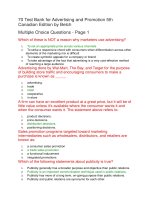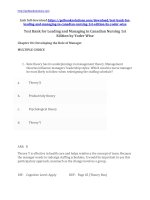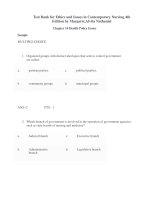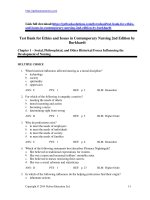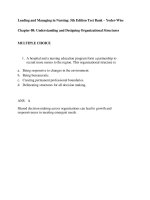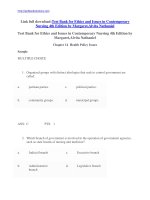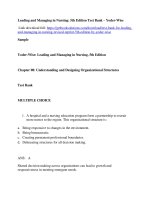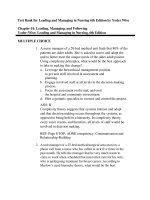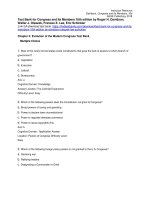ASTM D96-88 (1998) Standard Test Methods for Water and Sediment in Crude Oil by Centrifuge Method
Bạn đang xem bản rút gọn của tài liệu. Xem và tải ngay bản đầy đủ của tài liệu tại đây (80.4 KB, 7 trang )
Designation: D 96 – 88 (Reapproved 1998) An American National Standard
British Standard 4385
Designation: MPMS Chapter 10.4
American Association State
AMERICAN SOCIETY FOR TESTING AND MATERIALS Highway Transportation Standard
100 Barr Harbor Dr., West Conshohocken, PA 19428
AASHTO No. T55
Reprinted from the Annual Book of ASTM Standards. Copyright ASTM
Standard Test Method for
Water and Sediment in Crude Oil by Centrifuge Method
(Field Procedure)1
This standard is issued under the fixed designation D 96; the number immediately following the designation indicates the year of original
adoption or, in the case of revision, the year of last revision. A number in parentheses indicates the year of last reapproval. A superscript
epsilon (e) indicates an editorial change since the last revision or reapproval.
This method has been approved by the sponsoring committees and accepted by the Cooperating Societies in accordance with established
procedures.
This test method has been adopted for use by government agencies to replace Method 3003 of Federal Test Method Standard No. 791b.
Annex A1 is under revision and will be included in subsequent revisions to this standard.
1. Scope D 3699 Specification for Kerosine4
D 4006 Test Method for Water in Crude Oil by Distillation4
1.1 This test method covers the centrifuge method for D 4057 Practice for Manual Sampling of Petroleum and
determining sediment and water in crude oil during field
custody transfers. This test method may not always provide the Petroleum Products4
most accurate results, but it is considered the most practical D 4177 Practice for Automatic Sampling of Petroleum and
method for field determination of sediment and water. When a
higher degree of accuracy is required, the laboratory procedure Petroleum Products4
described in Test Methods D 4006, D 4377 or D 473 should be D 4377 Test Method for Water in Crude Oils by Potentio-
used.
metric Karl Fischer Titration4
NOTE 1—Water by distillation and sediment by extraction are consid- E 1 Specification for ASTM Thermometers5
ered the most accurate methods of determining sediment and water in E 542 Practice for Calibration of Volumetric Ware6
crude oils. As such, these methods should be employed to resolve 2.2 API Standards:7
differences in results from variations of this procedure or between this Manual of Petroleum Measurement Standards
procedure and other methods, or in the case of a dispute between parties. Chapter 8, Sampling Petroleum and Petroleum Products
Chapter 10, Sediment and Water
1.2 This standard does not purport to address all of the
safety concerns, if any, associated with its use. It is the 3. Summary of Test Method
responsibility of the user of this standard to establish appro-
priate safety and health practices and determine the applica- 3.1 Known volumes of crude oil and solvent (water satu-
bility of regulatory limitations prior to use. rated if required) are placed in a centrifuge tube and heated to
60°C 6 3°C (140°F 6 5°F). After centrifugation, the volume
2. Referenced Documents of the sediment-and-water layer at the bottom of the tube is
read.
2.1 ASTM Standards:
D 235 Specification for Mineral Spirits (Petroleum Spirits) NOTE 2—It has been observed that for some waxy crude oils, tempera-
tures of 71°C (160°F) or higher may be required to melt the wax crystals
(Hydrocarbon Drycleaning Spirits)2 completely so that they are not measured as sediment. If temperatures
D 362 Specification for Industrial Grade Toluene2 higher than 60°C (140°F) are necessary to eliminate this problem, they
D 473 Test Method for Sediment in Crude Oils and Fuel may be used with the consent of the parties involved. If water saturation
of the solvent is required, it must be done at the same temperature.
Oils by the Extraction Method3
D 846 Specification for Ten-Degree Xylene2 4. Significance and Use
D 1209 Test Method for Color of Clear Liquids (Platinum-
4.1 A determination of sediment and water content is
Cobalt Scale)2 required to determine accurately the net volumes of crude oil
involved in sales, taxation, exchanges, inventories, and custody
1 This test method is under the jurisdiction of Committee D-2 on Petroleum transfers. An excessive amount of sediment and water in crude
Products and Lubricants and is the direct responsibility of Subcommittee
D02.02.OB on Sediment and Water (Joint ASTM-JP). 4 Annual Book of ASTM Standards, Vol 05.02.
5 Annual Book of ASTM Standards, Vol 14.03.
Current edition approved March 25, 1988. Published December 1988. Originally 6 Annual Book of ASTM Standards, Vol 14.02.
published as D 96 – 63T. Last previous edition D 96 – 73 (1984).e1 7 Available from American Petroleum Institute, 1220 L St., Northwest, Wash-
ington, DC 20005.
2 Annual Book of ASTM Standards, Vol 06.04.
3 Annual Book of ASTM Standards, Vol 05.01.
1
D 96
oil is significant because it can cause corrosion of equipment
and problems in processing and transporting and may violate
federal, state, or municipal regulations.
5. Apparatus
5.1 Centrifuge—A centrifuge shall be capable of spinning
two or more centrifuge tubes at a speed that can be controlled
to give a minimum relative centrifugal force of 500 at the tip
of the tubes. The rotation speed necessary to produce a relative
centrifugal force of 500 for various diameters of swing can be
determined from Table 1 or from one of the following
equations:
r/min 5 1335 =rcf/d (1)
r/min 5 265 =rcf/d (2)
where: FIG. 1 Cone-Shaped Centrifuge Tube, 203 mm (8 in.)
rpm 5 rotation speed, in revolutions per minute.
rcf 5 relative centrifugal force, for closure with a stopper. Graduations for the 203-mm (8-in.)
d 5 diameter of swing, in mm (Eq 1) or in. (Eq 2), and 167-mm (6-in.) tubes shall be in accordance with the
requirements of Table 2 and Table 3, respectively. The scale
measured between the tips of opposite tubes when errors for a centrifuge tube shall not exceed the tolerances
the tubes are in their rotating position. specified in Table 2 and Table 3. The graduation requirements
The revolving head, trunnion rings, and trunnion cups, and scale-error tolerances shown in Table 2 and Table 3 apply
including the cushions, shall be constructed to withstand the to calibrations made by reading the bottom of the shaded
maximum centrifugal force capable of being delivered by the meniscus of air-free water at a temperature of 20°C (68°F). The
power source. The trunnion cups and cushions shall firmly graduations on each tube shall be clearly numbered as shown
support the tubes when the centrifuge is in motion. The in Fig. 1 and Fig. 2.
centrifuge shall be enclosed by a metal shield or case strong
enough to contain flying debris in the event a tube breaks or the 5.2.2 The tube graduation marks’ accuracy shall be volu-
centrifuge malfunctions. metrically verified or gravimetrically certified before field use
5.1.1 The centrifuge shall be heated and shall be capable of of the tube, in accordance with Practice E 542 using National
maintaining the sample at a temperature of 60°C 6 3°C Institute of Standards and Technology-traceable equipment.
(140°F6 5°F). The minimum allowable temperature in the The verification or certification shall include a calibration
field shall be 52°C (125°F). check at each mark up through the 0.5-mL (1-part) mark; at the
5.2 Centrifuge Tubes: 1-, 1.5-, and 2-mL (2-, 3-, and 4-part) marks: and at the 50- and
5.2.1 Centrifuge tubes shall be cone shaped and 203 mm (8 100-mL (100- and 200-part) marks. The tube shall not be used
in.) or 167 mm (6 in.) in length. Tubes shall conform to the
dimensions given in Fig. 1 (203 mm) or Fig. 2 (167 mm) and
shall be made of thoroughly annealed glass. A200-part tube
shall conform to the dimensions shown in Fig. 2, with the
marking for each division multiplied by 2 (for example, 25
mL 5 50 parts). The mouth of each tube shall be constricted
TABLE 1 Rotation Speeds Necessary to Produce a Relative
Centrifugal Force of 500 for Centrifuges of Various Diameters of
Swing
Diameter of SwingA Rotation Speed
(r/min)
Millimeters Inches
305 12 1710
330 13 1640
356 14 1580
381 15 1530
406 16 1480
432 17 1440
457 18 1400
483 19 1360
508 20 1325
533 21 1290
559 22 1260
584 23 1240
610 24 1210
AMeasured between the tips of the opposite tubes when the tubes are in rotating
position.
2
D 96
TABLE 3 Minimum Graduation Requirements and Maximum
Calibration Tolerances for 167-mm (6-in.) Cone-Shaped Tubes
Range, mL Subdivision, mL Volume Tolerance, mL
>0–0.1 0.05 60.02
60.03
>0.1–0.3 0.05 60.05
60.07
>0.3–0.5 0.05 60.10
60.20
>0.5–1.0 0.10 60.30
60.50
>1.0–1.5 0.10 60.75
61.0
>1.5–2.0 0.10 61.5
>2.0–3.0 0.20
>3.0–5.0 0.50
>5.0–10 1
>10–25 5
>25–100 A
AGraduations at 50 and 100.
FIG. 2 Cone-Shaped Centrifuge Tube, 167 mm (6 in.) thermometer such as ASTM 1C or 1F is suitable as shown in
Specification E 1.
TABLE 2 Minimum Graduation Requirements and Maximum
Calibration Tolerances for 203-mm (8-in.) Cone-Shaped Tubes 6. Reagents
Range, mL Subdivision, mL Volume 6.1 The reagents listed in this section are satisfactory for use
Tolerance, in field testing.
mL 6.2 Demulsifier—When necessary, a demulsifier should be
used to promote the separation of water from the sample, to
0–0.1 0.05 60.02 prevent water from the sample, clinging to the walls of the
>0.1–0.3 0.05 60.03 centrifuge tube, and to enhance the distinctiveness of the
>0.3–0.5 0.05 60.05 water-oil interface. In some cases a demulsifier is required to
>0.5–1.0 0.10 60.05 attain agreement with the base method (see Note 1). When a
>1.0–2.0 0.10 60.10 demulsifier is used, it should be mixed according to the
>2.0–3.0 0.20 60.10 manufacturer’s recommendations and should never add to the
>3.0–5.0 0.5 60.20 volume of sediment and water determined. The demulsifier
>5.0–10 1 60.50 should always be used in the form of a demulsifier-solvent
>10–25 5 61.00 stock solution or be premixed with the solvent to be used in the
>25–100 25 61.00 test.
if the scale error at any mark exceeds the applicable tolerance 6.3 Kerosine (Specification D 3699)
from Table 2 or 3. 6.3.1 The typical characteristics of kerosine are a distillation
range of 205-300°C (401-572°F), a maximum freezing point of
5.3 Preheater—The preheater shall be either a metal block − 30°C (−22°F), and a minimum flash point of 38°C (100°F).
or a liquid bath of sufficient depth to permit immersion of the 6.3.2 Stoddard solvent and kerosine do not have to be
centrifuge tube in the vertical position to the 100-mL litre saturated with water, since the solubility of water in these
(200-part) mark and capable of heating the sample to 60°C 6 solvents is not significant at 60°C (140°F).
3°C (140°F6 5°F).
NOTE 3—Warning: Kerosine is combustible (See A1.1).
5.4 Thermometer shall have graduations at intervals of 1°C
(2°F) or less and shall be accurate to 61°C (62°F). A 6.4 Stoddard Solvent (Specification D 235):
6.4.1 The typical characteristics of Stoddard solvent are a
distillation range of 149–208°C (300–407°F), a minimum flash
point of 38°C (100°F), and aromatics plus olefins content of
less than 20 % by volume.
NOTE 4—Warning: Stoddard solvent is combustible (See A1.2).
6.4.2 See 6.3.2.
6.5 Toluene (Specification D 362):
6.5.1 The typical characteristics of toluene are a molecular
weight of 92, an American Public Health Association (APHA)
color of 10 (in accordance with Test Method D1209), a boiling
range (initial to dry point) of 2.0°C (3.6°F) [recorded boiling
point of 110.6°C (231.1°F)], and 0.001 % residue after evapo-
ration. Toluene passes the American Chemical Society (ACS)
test for substances darkened by H2SO4.
NOTE 5—Warning: Toluene is flammable (See A1.3).
6.5.2 Toluene and xylene shall be saturated with water at
3
D 96
60°C 6 3°C (140°F 6 5°F) and maintained at this temperature 8.4 Place the tubes in the trunnion cups on opposite sides of
until used. A procedure for the saturation of solvents is given in the centrifuge to establish a balanced condition. Retighten the
the appendix. The water-saturated solvent shall be free from stoppers and spin for at least 5 minutes at a minimum relative
suspended water at the time of use. Toluene and xylene are centrifugal force of 500.
recommended for sediment-and-water determinations involv-
ing asphaltenic crude oils. 8.5 Immediately after the centrifuge comes to rest, verify
the temperature. Do not disturb the oil-water interface with the
6.6 Xylene (Specification D 846): thermometer. The test is invalid if the final temperature after
6.6.1 The typical characteristics of xylene are a molecular centrifugation is below 52°C (125°F).
weight of 106, an APHA color of not more than 10 (in
accordance with Test Method D 1209), a boiling range of 137 NOTE 8—If the final temperature is found to be below 52°C (125°F),
to 144°C (279 to 291°F), and 0.002 % residue after evapora- adjust the centrifuge heater to increase the final test temperature and
tion. Xylene passes the ACS test for substances darkened by reinitiate the procedure, beginning with 8.2.
sulfuric acid.
8.5.1 Read and record the combined volume of sediment
NOTE 6—Warning: Xylene is flammable (See A1.4). and water at the bottom of each tube as indicated in Table 4 and
Fig. 3 (Table 5 and Fig. 4 for 200-part tubes). Reheat both tubes
6.6.2 See 6.5.2. to 60°C 6 3°C (140°F 6 5°F), return the tubes without
agitation to the centrifuge, and spin for another 5 min at the
7. Sampling same rate. Repeat this operation until two consecutive consis-
tent readings are obtained on each tube.
7.1 Sampling is defined as all steps required to obtain a
representative quantity of the contents of any pipeline, tank, or 8.6 For the test to be considered valid, a clear interface must
other system and to place it in an appropriate centrifuge tube. be observed between the oil layer and the separated water. No
identifiable layering (that is, an emulsion) should be present
7.2 The sample shall be thoroughly representative of the immediately above the oil-water interface. In such cases, one
crude oil in question, and the portion of the sample used for the or more of the following remedies may be effective:
sediment and water determination shall be thoroughly repre-
sentative of the sample itself. If an automatic custody transfer 8.6.1 Shake the mixture between whirlings in the centrifuge
(LACT) unit is involved, vigorous agitation of the sample just enough to disperse the emulsion.
container is required before the sample is transferred to the
centrifuge tube or tubes. Only representative samples obtained 8.6.2 Use a different or an increased amount of demulsifier.
as specified in Practices D 4057 or D 4177 shall be used for (The demulsifier should not, however, contribute to the volume
this test method. of sediment and water.)
8. Procedure 8.6.3 Use a different or an increased amount of solvent.
After a satisfactory procedure for a particular type of oil has
8.1 Fill each of two centrifuge tubes to exactly the 50-mL been worked out, it will ordinarily be suitable for all samples
(100-part) mark with a sample taken directly from the sampling of the same crude oil.
device (for example, a thief bottle, beaker, or LACT sample
container) or the container in which the sample was collected. 9. Calculation and Report
Then fill each tube with solvent to exactly the 100-mL
(200-part) mark. Read the top of the meniscus at both the 50- 9.1 Compare the readings of the two tubes. If the difference
and 100-mL (100- and 200-part) marks. If experience indicates between the two readings is greater than one subdivision on the
that a demulsifier is required and one has not already been centrifuge tube (see Table 2 or 3) or 0.025 mL (0.05 % for
added to the solvent, add to each tube quantity of demulsifier- 200-part tubes) for readings of 0.10 mL (0.20 % for 200-part
solvent stock solution that has previously been determined to tubes) and below, the readings are inadmissible and the
be satisfactory for the crude oil under test. Stopper each tube determination shall be repeated.
tightly and invert the tubes a minimum of 10 times to ensure
that the oil and solvent are uniformly mixed. 9.2 If tubes graduated in 100 mL have been used for the
determination, record the sum of the final volumes of sediment
NOTE 7—Caution: In general, the vapor pressures of hydrocarbons at and water in each tube obtained, as specified in Section 8, and
60°C (140°F) are approximately double those at 40°C (104°F). Conse- report this sum as the percentage of sediment and water (see
quently, tubes should always be inverted at a position below eye level. Fig. 3 for reading and reporting sediment and water when using
100-mL cone-shaped centrifuge tubes). Report the results as
8.1.1 Where the crude oil is very viscous and mixing of the shown in Table 6.
solvent with the oil is difficult, the solvent may be added to the
centrifuge tube prior to the oil to facilitate mixing. In this case, 9.3 If direct-reading 200-part tubes have been used for the
extreme care must be taken to fill the centrifuge tube to exactly determination, the percentage of sediment and water is the
the 50-mL (100-part) mark with solvent and then to exactly the average, to three decimal places, of the values read directly
100-mL (200-part) mark with the sample. from the two tubes. The percentage can only be read directly
from a 200-part tube if the tube contains 50 mL or 100 parts of
8.2 Loosen the stoppers to prevent pressure buildup during oil.
heating and immerse the tubes to the 100-mL (200-part) mark
in a preheater. Heat the contents to 60°C 6 3°C (140°F 6 5°F). TABLE 4 Procedure for Reading a 100-mL Cone-Shaped Tube
8.3 Secure the stoppers and again invert the tubes 10 times Volume of Sediment and Water, mL Read to Nearest, mL
to ensure uniform mixing of the oil and solvent.
0.0–0.2 0.025
0.2–1.0 0.05
>1.0 0.10
4
D 96
FIG. 3 Procedure for Reading Sediment and Water When Using a FIG. 4 Procedure for Reading Sediment and Water When Using a
Tube Reading in 100 mL Tube Reading in 200 Parts
TABLE 5 Procedure for Reading a 200-Part Cone-Shaped Tube TABLE 6 Expression of Results
Volume of Sediment and Water, % Read to Nearest,% Volume of Sediment and Water, mL Total Sediment and
Water, %
0.0–0.4 0.05 Tube 1 Tube 2
0.4–2.0 0.10 None visible Trace 0
None visible 0.025 0.025
>2.0 0.20 0.025 0.5
0.025 0.05 0.075
9.4 If the volume of oil is greater or less than 50 mL, or 100 0.025 0.05 0.10
parts, calculate the percentage of sediment and water as 0.05 0.075 0.125
follows: 0.05 0.075 0.15
0.075 0.10 0.175
Sediment and water, percent 5 ~S/V! 3 100 0.075 0.10 0.20
(3) 0.10 0.15 0.25
0.10
where: temperature of the final mixture after centrifuging.
S 5 volume of sediment and water, mL or parts and 9.5.4 The number of samples or tubes used in the determi-
V 5 volume of oil tested, mL or parts.
nation.
For example, if the total volume of oil tested (V) is 20 mL
and the volume of sediment and water (S) is 0.15 mL: 10. Precision and Bias
Sediment and water, % 5 ~0.15/20! 3 100 5 0.75 (4) 10.1 Precision—The precision of this test method is being
determined.
9.5 If the test conditions outlined in Section 6 are not
followed exactly, the following must also be reported: 10.2 Bias—Since there is no accepted reference material
suitable for determining the bias, no statement about bias is
9.5.1 The solvent used and the water saturation temperature. being made.
9.5.2 The type and amount of demulsifier (if used).
9.5.3 The temperatures of the sample and solvent, the
preheater temperature, the centrifuge temperature, and the
5
D 96
11. Keywords
11.1 centrifuge; centrifuge tube; crude oil; field procedure;
sampling; sediment and water; solvent
ANNEX
(Mandatory Information)
A1. PRECAUTIONARY STATEMENTS
A1.1 Kerosine—Keep away from heat, sparks, or open is harmful. Provide adequate ventilation when toluene is used,
flame. Keep container closed when not in use. Kerosine’s and airborne concentrations should be kept below the estab-
vapor is harmful. Provide adequate ventilation when kerosine lished exposure limits. The Occupational Safety and Health
is used. Neither an Occupational Safety and Health Adminis- Administrator has established a permissible exposure limit of
tration permissible exposure limit nor an American Conference 200 parts/million, with an acceptable ceiling of 300 parts/
of Governmental Industrial Hygienists threshold limit value million and an acceptable maximum peak of 500 parts/million
has been established for kerosine. Ingestion of kerosine may for 10 min. The American Conference of Governmental
cause irritation of the digestive tract; ingestion of large Industrial Hygienists has established a threshold limit value of
amounts may cause signs of central nervous system depression. 100 parts/million, with a short-term exposure limit of 150
Aspiration of this material into the nervous system depression. parts/million for 1 min. Prolonged overexposure through inha-
Repetitive applications of kerosine directly to the skin of lation may cause coughing, shortness of breath, dizziness and
laboratory animals over their lifetimes has resulted in skin intoxication. Aspiration of this material into the lungs may
cancer in the animals. Petroleum hydrocarbons of similar cause chemical pneumonia. Long-term exposure to this mate-
composition and boiling range have been shown to produce rial may cause chronic health effects. Toluene may remove fats
kindey damage and tumors in laboratory animals. Avoid skin from the skin and cause chronic dermatitis. Other potential
contact with kerosine. Prolonged or repeated skin contact may hazards include possible liver, kidney, and nervous system
cause defatting and drying of the skin. damage and cardiac sensitization to epinephrine. In addition,
toluene has been shown to be toxic to the embryo and fetus at
A1.2 Stoddard Solvent—Keep away from heat, sparks, or high concentrations in animal experiments, however, such
open flame. Its container should be kept closed when not in studies have failed to demonstrate frank birth defects. Pro-
use. The solvent’s vapor is harmful. Adequate ventilation longed or repeated skin contact may cause skin to become dry
should be provided when the solvent is used, and airborne or cracked.
concentrations should be kept below the established exposure
limits. The permissible exposure limit established by the A1.4 Xylene—Keep away from heat, sparks, or open flame.
Occupational Safety and Health Administration for Stoddard Keep container closed when not in use. Xylene’s vapor is
solvent is 500 parts/million. The American Conference of harmful. Provide adequate ventilation when xylene is used, and
Governmental Industrial Hygienists has established a threshold keep airborne concentrations below established exposure lim-
limit value of 100 parts per million. Inhalation of vapors or its. The Occupational Safety and Health Administration’s
spray mist should be avoided. Acute overexposure may result permissible exposure limit for xylene is 100 parts/million. The
in irritation of the throat and lungs. High concentrations may American Conference of Governmental Industrial Hygienists
cause central nervous system depression. Aspiration of this has established a threshold limit value of 100 parts/million with
material into the lungs may cause chemical pneumonia. Long- a 15-min short-term exposure limit of 150 parts/million.
term exposure can cause chronic health effects. Chronic Overexposure through inhalation may cause shortness of
overexposure has resulted in liver, heart, and blood disorders. breath, dizziness, intoxication, and collapse. Aspiration of this
Intense and protracted exposure to the solvent may be associ- material into the lungs may cause chemical pneumonia. Long-
ated with an increased risk of kidney cancer, kidney disease, term exposure to this material can cause chronic health effects.
and nerve and brain damage. Avoid skin contact with the Prolonged, repeated exposure to high levels of xylene can
solvent. Prolonged or repeated contact with the liquid can induce central nervous system problems and may cause liver
result in drying and defatting of the skin that may result in and kidney damage. Avoid prolonged or repeated skin contact
irritation and dermatitis. with xylene. Skin contact may result in delayed skin irritation
and blistering.
A1.3 Toluene—Keep away from heat, sparks, or open
flame. Keep container closed when not in use. Toluene’s vapor
6
D 96
APPENDIX
(Nonmandatory Information)
X1. DEMULSIFIERS AND WATER SATURATION OF SOLVENTS
X1.1 Water Saturation of Solvents: some crudes for which one demulsifier is more effective than
another. If the selected demulsifier does not provide the desired
X1.1.1 Fill each of two centrifuge tubes to the 2-mL (4-part) results, others should be tried.
mark with water and then to the 100-mL (200-part) mark with
the solvent to be saturated. X1.2.2 Overtreatment with a demulsifier can add errone-
ously to the apparent sediment and water level. Demulsifiers do
X1.1.2 Stopper the tubes and shake vigorously for 30 s, not in general contain water, but they do have a limited
holding the tubes below eye level, to disperse the water in the solubility in the solvent-sample and, if added in excessive
solvent. Loosen the stoppers. quantities, can show up after centrifuging as a separate
immiscible component at the bottom of the tube. To prevent
X1.1.3 Place the tubes containing the water/solvent mixture this problem, the demulsifier should always be used in the form
into a sample preheater or heated (nonspinning) centrifuge of a demulsifier-solvent stock solution or should be premixed
maintained at a temperature of 60°C (140°F) for a minimum of with the solvent to be used in the test. In either case, the
30 min. quantity of demulsifier to be added to the solvent should be
based on tests for the particular demulsifier solvent combina-
X1.1.4 Inspect the water/solvent mixture for suspended tion. The demulsifier manufacturer’s instructions should be
water droplets before use. If any suspended water is visible, the followed when a demulsifier solution is prepared.
tubes must be centrifuged at a temperature of 60°C (140°F) for
5 min at a speed sufficient to give a relative centrifugal force of X1.3 Demulsifiers and demulsifier-solvent solutions should
500 at the tube tip. always be stored in accordance with the manufacturer’s rec-
ommendations. Each container used to store a demulsifier or
X1.1.5 Use the top 50 mL (100 parts) of the mixture from demulsifier-solvent solution should be dated, and the contents
each tube for test purposes. Take particular care not to pour any should be discarded when they reach the demulsifier manufac-
of the free water in the tip of each tube into the sample. turer’s recommended shelf life.
X1.2 Demulsifiers:
X1.2.1 Although a good commercial crude-oil demulsifier
will work effectively with a wide range of crude oils, there are
The American Society for Testing and Materials takes no position respecting the validity of any patent rights asserted in connection
with any item mentioned in this standard. Users of this standard are expressly advised that determination of the validity of any such
patent rights, and the risk of infringement of such rights, are entirely their own responsibility.
This standard is subject to revision at any time by the responsible technical committee and must be reviewed every five years and
if not revised, either reapproved or withdrawn. Your comments are invited either for revision of this standard or for additional standards
and should be addressed to ASTM Headquarters. Your comments will receive careful consideration at a meeting of the responsible
technical committee, which you may attend. If you feel that your comments have not received a fair hearing you should make your
views known to the ASTM Committee on Standards, 100 Barr Harbor Drive, West Conshohocken, PA 19428.
7
